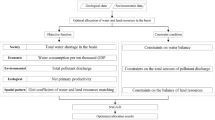Abstract
Water is a key restricting factor of the economic development and eco-environmental protection in arid inland river basins of Northwest China. Although water supplies are short, the water utilization structure and the corresponding industrial structure are unbalanced. We constructed a System Dynamic Model for mutual optimization based on the mechanism of their interaction. This model is applied to the Heihe River Basin where the share of limited water resources among ecosystem, production and human living is optimized. Results show that, by mutual optimization, the water utilization structure and the industrial structures fit in with each other. And the relationships between the upper, middle and lower reaches of the Heihe River Basin can be harmonized. Mutual benefits of ecology, society and economy can be reached, and a sustainable ecology-production-living system can be obtained. This study gives a new insight and method for the sustainable utilization of water resources in arid inland river basins.
Similar content being viewed by others
References
Bindra S P, Moh’d Muntasser et al., 2003. Water use efficiency for industrial development in Libya. Desalination, 158: 167–178.
Chen Z K et al., 2004. Study on the Strategies of Water Resources Optimization, Eco-environmental Construction and Sustainable Development in Northwest China (water resources volume). Beijing: Science Press, 113–114.
Cheng G D, 2002. Study on the sustainable development in the Heihe River Watershed from the view of ecological economics. Journal of Glaciology and Geocryology, 24(4): 335–343.
David W Watkins Jr, Daene C McKinney, 1998. Decomposition methods for water resources optimization models with fixed costs. Advances in Water Resources, 21(4): 283–295.
Esther Vela´zquez, 2005. An input-output model of water consumption: analysing intersectoral water relationships in Andalusia. Ecological Economics, 6(2): 1–15.
Feiring B R, T SastrilL et al., 1998. A stochastic programming model for water resource planning. Mathematical and Computer Modelling, 27(3): 1–7.
John P Holdren et al., 1996. The Meaning of Sustainability: Biogeophysical Aspects. Defining and Measuring Sustainability. New York: The Biogeophysical Foundations, 19–56.
Lan Y C et al., 2003. Water resources change and its trends forecasted by Grey Markov Chain in Heihe River Basin. Journal of Desert Research, 23(4): 435–440.
Li X J, 1999. Economic Geography. Beijing: Higher Education Press, 171–172.
Liu C M et al., 2004. Study on the Strategies of Water Resources Optimization, Eco-Environmental Construction and Sustainable Development in Northwest China (eco-environment volume). Beijing: Science Press, 314–315.
Qian X S, 1985. Strategy of system thought and scientific & technological development. Xi’an: Xi’an Jiaotong University Press.
Qu Y G, Fan S Y, 2000. Water resources capacity and developing strategies in Heihe River Basin. Journal of Desert Research, 20(1): 1–8.
Saghir J et al., 2000. Urban water and sanitation in the MENA region: The way forward. The World Bank.
Su Z Y et al., 2002. Fundamental ecological study on the carrying capacity of water resources in Heihe River Watershed. Journal of Glaciology and Geocryology, 24(4): 400–406.
Vacik H, Lexer M J, 2001. Application of a spatial decision support system in managing the protection forests of Vienna for sustained yield of water resources. Forest Ecology and Management, 14(3): 65–76.
Wang Q F, 1995. Advanced System Dynamics. Beijing: Tsinghua University Press.
Wang S J, Hou Y et al., 2002. Study on the development of optimal allocation theory of water resources. China Population, Resources and Environment, 12(5): 79–81.
Wu J S, 1995. Actuality and trend on agricultural water resources assessment in China and abroad. Groundwater, 17(1): 1–3.
Xu H J, Ding K L, Wu T Z, 2002. Analysis on the actuality of water utilization in Zhejiang province by comparison in China and abroad. Zhejiang Water Conservancy Science and Technology, (3): 63–65.
Yang Z F et al., 2003. Theory, Methods and Practice on Water Demand for Eco-environment. Beijing: Science Press.
Zhang K M, 1997. Sustainable Development Theory. Beijing: China Environmental Science Press, 80–81.
Zhu Y H et al., 2004. A survey: obstacles and strategies for the development of ground-water resources in arid inland river basins of western China. Journal of Arid Environments, 59: 351–367.
Author information
Authors and Affiliations
Additional information
Foundation: Key Project of National Natural Science Foundation of China, No.40335049; National Natural Science Foundation of China, No.40471059
Rights and permissions
About this article
Cite this article
Bao, C., Fang, C. & Chen, F. Mutual optimization of water utilization structure and industrial structure in arid inland river basins of Northwest China. J GEOGR SCI 16, 87–98 (2006). https://doi.org/10.1007/s11442-006-0109-z
Received:
Accepted:
Issue Date:
DOI: https://doi.org/10.1007/s11442-006-0109-z




